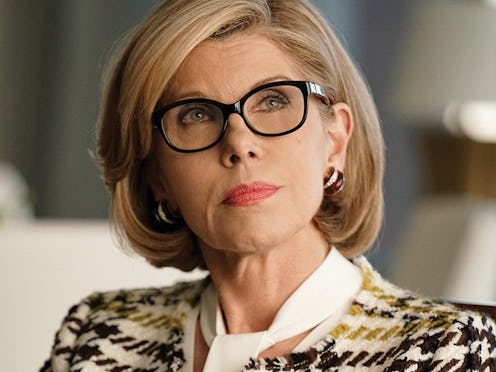Entertainment
Why Christine Baranski's Age In 'The Good Fight' Is NBD

When The Good Wife creators Robert and Michelle King decided to make a spinoff of the show, they knew they were taking a risk — well, more accurately, a lot of risks. Not featuring Wife star Julianna Margulies as Alicia in any episodes was a big one, but so was moving to the streaming-only CBS All Access, criticizing the Trump administration in its episodes, and, perhaps most daringly of all, having the 64-year-old Christine Baranski be one of the show's primary stars. Although plenty of older men have led TV shows, the medium has, historically, been a less welcoming place for women over 40 or 50, and so the Kings were prepared for some pushback. Happily, however, the amount of criticism they got from viewers or the network due to Baranski's age was "absolutely none," Michelle tells me.
"Everyone at CBS adores Christine Baranski just as much as we do, so it was a non-issue," explains the showrunner, speaking on the phone shortly before The Good Fight's Season 1 finale alongside her husband. Baranski was, of course, a major player on The Good Wife, but her larger role on Fight means that her personal life — including her relationship with estranged husband Kurt (Gary Cole) — frequently takes center stage. With Hollywood's age bias being what it is, few older women in TV or movies get to explore romance on-screen, but Diane's love life is — and will continue to be — a central part of her character arc on the show.
"One of the things we want to do next season is see Diane’s personal life more," reveals Robert. Sadly, though, Cole being an in-demand actor on other series means that the Diane-Kurt romance might not get as much focus as the showrunners would like. "I wish that their marriage weren’t guided by availability, but it does impact it," says Michelle, joking that the direction of Diane and Kurt's romance "is an excellent question for the showrunners of Veep." (Cole stars on the HBO show as Kent, a political consultant.)
But, adds Robert, "the more episodes that we get him for, the more you’ll see what that relationship is about, which doesn’t even mean that’s for the good — it could be up and down."
Whatever ways Diane's personal life ends up being explored, the fact that a woman in her 60s is allowed to play a complex, sexual character, without criticism from the network she stars on or the viewers of her show, is a major step in the right direction for TV. "What’s really nice and kind of, I hope, a harbinger of the future, is that people have not harped on some things we worried [about] — the age of the protagonist, and also the sexual orientation of Maia," says Robert. "They were things that felt like they were going to be big hurdles, and they weren’t at all."
For those unfamiliar, the showrunner is referring to Maia (Rose Leslie) being a lesbian; in the first episode of the season, it's established that the young lawyer is in a serious relationship with her girlfriend, but otherwise, her sexual orientation is no more defining of her character than that of her straight co-workers. This is a significant, welcome change from the norm of TV and film, where LGBTQ lead characters — who already exist far too infrequently — are often summarized by their sexualities, rather than their personality traits or actions. Maia, however, is a fully-formed individual, whose romantic life actually takes a backseat to her family drama and work at the law firm.
It's the kind of subtle but substantial decision that, along with Diane's age, has made The Good Fight one of the most quietly progressive shows on TV.
"We’re very fortunate in that we have a show with enough women characters that it allows them not to be stereotyped, that you get to see that they’re women who can like each other, that can work together, and they’re all different sorts of people with different sorts of styles of work. And that’s a luxury," says Michelle.
A luxury, yes, but also perhaps, like Robert says, a harbinger of the future — a TV landscape where women of all ages and sexual orientations can, and should, co-exist like it's no big deal at all.